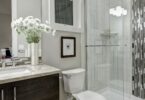Barn doors have a long history that dates back to the 19th century when they were commonly used in barns and farmhouses. These doors were known for their durability and functionality, as they were able to withstand the harsh conditions of rural life. However, in recent years, barn doors have experienced a resurgence in popularity and have become a staple in modern home design.
The growing popularity of barn doors can be attributed to several factors. Firstly, their unique aesthetic appeal sets them apart from traditional hinged doors. Barn doors add a touch of rustic elegance to any space, creating a warm and inviting atmosphere. Additionally, barn doors are highly versatile and can be incorporated into various design styles, making them a popular choice for homeowners looking to add character and charm to their homes.
The Charm of Rustic Elegance: Why Barn Doors are a Must-Have
One of the main reasons why barn doors have become a must-have in modern home design is their unique aesthetic appeal. These doors exude a sense of rustic elegance that is hard to replicate with other types of doors. The natural wood grain and distressed finishes give barn doors a weathered look that adds character and warmth to any room.
Barn doors can be used in various ways to enhance the overall design of a space. They can serve as a focal point, drawing attention and creating visual interest. They can also be used to divide open-concept spaces, providing privacy while still allowing for an open feel. Additionally, barn doors can be customized with different hardware options, such as handles and hinges, to further enhance their aesthetic appeal.
The versatility of barn doors is another reason why they are a must-have in modern home design. These doors can be incorporated into different design styles, from farmhouse to industrial to contemporary. They can be used in bedrooms, bathrooms, living rooms, kitchens, and even as closet doors. The possibilities are endless, and homeowners can get creative with how they use barn doors to enhance their spaces.
Choosing the Right Barn Door: Materials, Styles, and Finishes
When it comes to choosing the right barn door for your home, there are several factors to consider. One of the first decisions you’ll need to make is the material of the door. Barn doors can be made from a variety of materials, including solid wood, reclaimed wood, metal, and glass. Each material has its own unique characteristics and can contribute to the overall aesthetic of the space.
Solid wood barn doors are a popular choice for their natural beauty and durability. They can be stained or painted to match any design style and can be customized with different finishes, such as distressed or weathered. Reclaimed wood barn doors are another option for those looking for a more rustic look. These doors are made from salvaged wood, giving them a unique and aged appearance.
In terms of style, there are several popular options to choose from. Traditional barn doors feature a classic design with horizontal planks and a Z-shaped brace for added stability. Modern barn doors, on the other hand, have a sleeker and more minimalist look, often featuring clean lines and a smooth finish. There are also options for paneled barn doors, which add a touch of elegance and sophistication to any space.
When it comes to finishes, there are endless possibilities. From natural wood tones to bold colors to distressed finishes, you can choose a finish that complements your overall design scheme. It’s important to consider the existing elements in your space and choose a finish that will harmonize with them.
Installing Barn Doors: DIY vs. Professional Installation
Once you’ve chosen the right barn door for your home, you’ll need to decide whether to install it yourself or hire a professional. There are pros and cons to both options, and it ultimately depends on your level of skill and comfort with DIY projects.
One of the main advantages of DIY installation is cost savings. Hiring a professional can be expensive, and if you’re on a tight budget, installing the barn door yourself can be a more affordable option. Additionally, DIY installation allows you to have full control over the process and ensures that the door is installed exactly how you want it.
However, there are also drawbacks to DIY installation. Installing a barn door requires some level of carpentry skills and knowledge of tools. If you’re not experienced in these areas, you may run into difficulties during the installation process. Additionally, improper installation can lead to issues such as misalignment or damage to the door or wall.
If you’re not confident in your DIY skills or simply don’t have the time or patience to tackle the installation yourself, hiring a professional is the way to go. A professional installer will have the necessary expertise and tools to ensure that the barn door is installed correctly and securely. They will also be able to handle any challenges that may arise during the installation process.
When deciding whether to DIY or hire a professional, it’s important to consider your own abilities and limitations. If you’re comfortable with DIY projects and have some experience with carpentry, installing a barn door yourself can be a rewarding and cost-effective option. However, if you’re unsure or don’t have the necessary skills, it’s best to leave it to the professionals.
Barn Doors for Every Room: From Bedrooms to Bathrooms
Barn doors are not just limited to one room in the house – they can be used in virtually any room to add style and functionality. Here are some creative ways to incorporate barn doors in different rooms of your home:
1. Bedrooms: Barn doors can be used as bedroom doors, replacing traditional hinged doors. They can create a dramatic entrance and add a touch of rustic elegance to the space. Additionally, barn doors can be used as closet doors, providing a unique and stylish alternative to traditional sliding or bifold doors.
2. Bathrooms: Barn doors can be used in bathrooms to separate the toilet or shower area from the rest of the space. This provides privacy while still maintaining an open and airy feel. Barn doors can also be used as shower enclosures, adding a rustic and spa-like touch to the bathroom.
3. Living Rooms: Barn doors can be used to divide open-concept living spaces, creating separate areas for different activities. For example, a barn door can be used to separate the living room from the dining area or home office. This allows for privacy when needed while still maintaining an open and cohesive design.
4. Kitchens: Barn doors can be used in kitchens to hide pantries or storage areas. They can also be used as cabinet doors, adding a unique and stylish touch to the kitchen design. Additionally, barn doors can be used to separate the kitchen from other areas of the home, such as the dining room or living room.
5. Home Offices: Barn doors can be used in home offices to create a separate and private workspace. They can be used to close off the office when not in use, providing a quiet and distraction-free environment. Barn doors can also be used as bookcase or storage unit doors, adding a stylish and functional element to the space.
Maximizing Space with Sliding Barn Doors: Tips and Tricks
One of the main advantages of barn doors is their ability to save space, making them an ideal choice for small rooms or tight spaces. Here are some tips and tricks for maximizing space with sliding barn doors:
1. Choose sliding barn doors: Sliding barn doors are a great option for small rooms because they don’t require any floor space to swing open or closed. Instead, they slide along a track mounted on the wall, allowing you to make the most of the available space.
2. Opt for a single sliding door: If you have a small room, consider using a single sliding barn door instead of double doors. Double doors require more wall space to accommodate the opening and closing motion, whereas a single door can slide along one side of the wall, saving valuable space.
3. Use mirrored barn doors: Mirrored barn doors are a clever way to maximize space in small rooms. The mirrors not only create the illusion of a larger space but also serve a functional purpose. Mirrored barn doors can be used in bedrooms, bathrooms, or closets to provide a full-length mirror while saving space.
4. Consider bypass barn doors: Bypass barn doors are another option for maximizing space in small rooms. These doors slide on multiple tracks, allowing them to overlap each other when opened or closed. Bypass barn doors are ideal for areas where there isn’t enough wall space for a traditional sliding door.
5. Use barn doors as room dividers: Barn doors can be used as room dividers to create separate areas within a larger space. This is especially useful in open-concept homes where there is a need for privacy or separation between different areas. By using barn doors as room dividers, you can create distinct zones without sacrificing valuable floor space.
Adding Functionality with Barn Doors: Storage, Privacy, and More
Barn doors are not just aesthetically pleasing – they also offer several functional benefits that can enhance your home design. Here are some ways in which barn doors can add functionality to your space:
1. Storage solutions: Barn doors can be used to conceal storage areas such as pantries, closets, or laundry rooms. By using barn doors instead of traditional hinged doors, you can save valuable floor space and create a seamless and cohesive look in your home.
2. Privacy in open-concept spaces: Open-concept homes are becoming increasingly popular, but they can sometimes lack privacy. Barn doors can be used to separate different areas of an open-concept space, providing privacy when needed. For example, a barn door can be used to close off a home office or a playroom from the rest of the living area.
3. Noise reduction: Barn doors can help reduce noise transmission between rooms. The solid construction of barn doors, combined with their ability to seal off a space, makes them an effective solution for reducing noise in your home. This is especially useful in areas such as bedrooms or home offices where privacy and quiet are important.
4. Accessibility: Barn doors are a great option for people with mobility issues or disabilities. The sliding motion of barn doors makes them easier to open and close compared to traditional hinged doors. Additionally, barn doors can be customized with handles and hardware that are easy to grip and operate.
5. Versatility: Barn doors can be used in various ways to add functionality to your space. For example, they can be used as room dividers, allowing you to create separate areas within a larger space. They can also be used as cabinet or pantry doors, providing easy access to storage areas while adding a stylish touch to your kitchen or dining area.
The Perfect Match: Pairing Barn Doors with Other Design Elements
When incorporating barn doors into your home design, it’s important to consider how they will work with other design elements in the space. Here are some tips for pairing barn doors with other design elements:
1. Consider the overall style: Before choosing a barn door, consider the overall style of your home. If you have a farmhouse-style home, a traditional barn door with rustic finishes would be a perfect match. On the other hand, if you have a more modern or contemporary home, a sleek and minimalist barn door would complement the design.
2. Coordinate with existing finishes: Take into account the existing finishes in your space, such as flooring, cabinetry, and hardware. Choose a barn door finish that complements these elements and creates a cohesive look. For example, if you have dark wood flooring, a barn door with a similar wood tone would create a harmonious design.
3. Use contrasting colors: If you want to make a statement with your barn door, consider using contrasting colors. For example, if you have a white or neutral-colored room, a barn door in a bold color such as red or navy blue would create a striking focal point. Conversely, if you have a colorful room, a barn door in a neutral color would provide balance and allow other elements to shine.
4. Pay attention to hardware: The hardware you choose for your barn door can greatly impact its overall look and feel. Consider the style and finish of the hardware and how it will complement the design of the door and the space. For example, if you have a rustic barn door, choose hardware with an antique or distressed finish to enhance the rustic charm.
5. Create a cohesive design scheme: When incorporating barn doors into your home design, it’s important to create a cohesive look throughout the space. Consider how the barn doors will flow with other elements such as furniture, lighting, and accessories. Choose colors, textures, and materials that complement each other and create a harmonious design scheme.
Maintaining Barn Doors: Cleaning and Care Tips
To keep your barn doors looking their best and ensure their longevity, it’s important to clean and maintain them regularly. Here are some tips for cleaning and caring for your barn doors:
1. Dust regularly: Like any other piece of furniture or decor, barn doors can accumulate dust over time. To keep them looking clean and fresh, dust them regularly using a soft cloth or duster. Pay special attention to the corners and crevices where dust tends to accumulate.
2. Clean with a mild detergent: If your barn doors are stained or have a finish, you can clean them with a mild detergent and water solution. Mix a small amount of detergent with warm water and use a soft cloth or sponge to gently clean the surface of the door. Avoid using abrasive cleaners or scrub brushes, as they can damage the finish.
3. Avoid excessive moisture: Barn doors are typically made from wood, which can be sensitive to moisture. Avoid excessive exposure to water or humidity, as it can cause the wood to warp or swell. If your barn doors are in a high-moisture area such as a bathroom, consider sealing them with a waterproof finish to protect them from moisture damage.
4. Check for damage: Regularly inspect your barn doors for any signs of damage, such as cracks, chips, or loose hardware. If you notice any issues, address them promptly to prevent further damage. Repair any cracks or chips using wood filler or touch-up paint, and tighten any loose hardware.
5. Lubricate the hardware: The hardware on your barn doors, such as the track and rollers, may require occasional lubrication to ensure smooth operation. Use a silicone-based lubricant or a dry lubricant spray to lubricate the hardware. Avoid using oil-based lubricants, as they can attract dust and dirt.
Barn doors have become increasingly popular in modern home design due to their unique aesthetic appeal and functional benefits.








